
Archery is the sport, practice, or skill of using a bow to shoot arrows. The word comes from the Latin arcus, meaning bow. Historically, archery has been used for hunting and combat. In modern times, it is mainly a competitive sport and recreational activity. A person who practices archery is typically called an archer, bowman, or toxophilite.

An arrow is a fin-stabilized projectile launched by a bow. A typical arrow usually consists of a long, stiff, straight shaft with a weighty arrowhead attached to the front end, multiple fin-like stabilizers called fletchings mounted near the rear, and a slot at the rear end called a nock for engaging the bowstring. A container or bag carrying additional arrows for convenient reloading is called a quiver.

In modern archery, a compound bow is a bow that uses a levering system, usually of cables and pulleys, to bend the limbs. The compound bow was first developed in 1966 by Holless Wilbur Allen in North Kansas City, Missouri, and a US patent was granted in 1969. Compound bows are widely used in target practice and hunting.

Kyūdō is the Japanese martial art of archery. Kyūdō is based on kyūjutsu, which originated with the samurai class of feudal Japan. In 1919, the name of kyūjutsu was officially changed to kyūdō, and following the example of other martial arts that have been systematizing for educational purposes, kyūdō also reorganized and integrated various forms of shooting that had been used up until then. Many practitioners may refer to themselves as yumihiki (弓引き), or 'ones who draw the bow'. Kyūdō is practised by over a hundred thousand people worldwide. The bow they use is called a yumi (弓). It has an asymmetrical shape and length of more than 2.0 metres, and its use is characterized by the archer gripping the lower third of the bow stave to shoot.
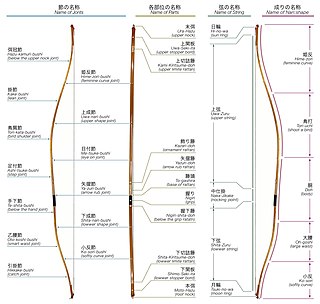
Yumi is the Japanese term for a bow. As used in English, yumi refers more specifically to traditional Japanese asymmetrical bows, and includes the longer daikyū and the shorter hankyū used in the practice of kyūdō and kyūjutsu, or Japanese archery.

The bow and arrow is a ranged weapon system consisting of an elastic launching device (bow) and long-shafted projectiles (arrows). Humans used bows and arrows for hunting and aggression long before recorded history, and the practice was common to many prehistoric cultures. They were important weapons of war from ancient history until the early modern period, where they were rendered increasingly obsolete by the development of the more powerful and accurate firearms. Today, bows and arrows are mostly used for hunting and sports.
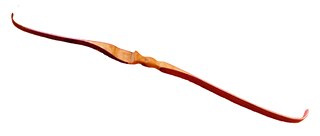
In archery, the shape of the bow is usually taken to be the view from the side. It is the product of the complex relationship of material stresses, designed by a bowyer. This shape, viewing the limbs, is designed to take into account the construction materials, the performance required, and the intended use of the bow.
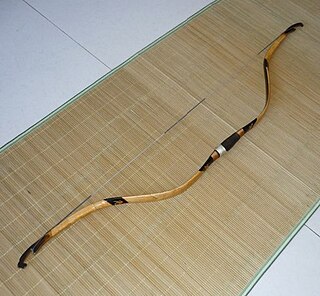
A composite bow is a traditional bow made from horn, wood, and sinew laminated together, a form of laminated bow. The horn is on the belly, facing the archer, and sinew on the outer side of a wooden core. When the bow is drawn, the sinew and horn store more energy than wood for the same length of bow. The strength can be made similar to that of all-wood "self" bows, with similar draw-length and therefore a similar amount of energy delivered to the arrow from a much shorter bow. However, making a composite bow requires more varieties of material than a self bow, its construction takes much more time, and the finished bow is more sensitive to moisture.

A bracer is a strap or sheath, commonly made of leather, stone or plastic, that covers the ventral (inside) surface of an archer's bow-holding arm. It protects the archer's forearm against injury by accidental whipping from the bowstring or the fletching of the arrow while shooting, and also prevents the loose sleeve from catching the bowstring. They normally only cover part of the forearm, but full-length bracers extending to the upper arm are also available, and other areas have been covered by some archers. In addition, chest guards are sometimes worn, usually by female archers, to protect the breast. With some combinations of non-baggy clothing and bows with a larger distance between the bow and the string, the archer may not need to wear any bracer.

In archery, a finger tab or archer tab is a small leather or synthetic patch that protects an archer's fingers from the bowstring. It is strapped or otherwise attached to an archer's hand. In summertime, tabs are far more comfortable than gloves and can more conveniently use thicker material. They are also less expensive and easier to fit, and are the normal finger-protection used with recurve bows.
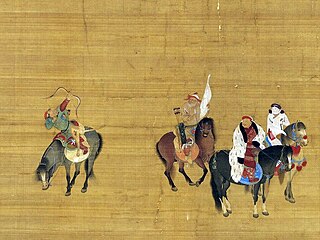
The Mongol bow is a type of recurved composite bow historically used in Mongolia, and by the horse archers of the Mongol Empire. "Mongol bow" can refer to two types of bow. From the 17th century onward, most of the traditional bows in Mongolia were replaced with the similar Manchu bow which is primarily distinguished by larger siyahs and the presence of prominent string bridges.
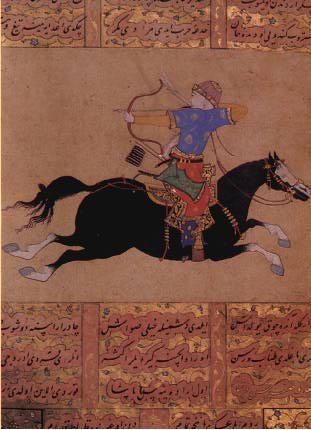
Turkish archery is a tradition of archery which became highly developed in the Ottoman Empire, although its origins date back to the Eurasian Steppe in the second millennium BC.

A flu-flu arrow is a type of arrow specifically designed to travel a short distance. Such arrows are particularly useful when shooting at aerial targets or for certain types of recreational archery where the arrow must not travel too far. One of the main uses of these arrows is that they do not get lost as easily if they miss the target.

Target archery is the most popular form of archery, in which members shoot at stationary circular targets at varying distances. All types of bow – longbow, barebow, recurve and compound – can be used. In Great Britain, imperial rounds, measured in yards, are still used for many tournaments and these have slightly different rules to metric (WA) rounds, which are used internationally. Archers are divided into seniors and juniors, with juniors being those under the age of 21.

The archer's paradox is the phenomenon of an arrow traveling in the direction it is pointed at full draw, when it seems that the arrow would have to pass through the starting position it was in before being drawn, where it was pointed to the side of the target.
A bow draw in archery is the method or technique of pulling back the bowstring to store energy for the bow to shoot an arrow. The most common method in modern target archery is the Mediterranean draw, which has long been the usual method in European archery. Other methods include the pinch draw and the Mongolian or "thumb" draw. In traditional archery practice outside Western Europe the variations of the thumb draw are by far the most dominant draw types, with the Mediterranean draw restricted to the Olympic style of target archery.
This is a list of archery terms, including both the equipment and the practice. A brief description for each word or phrase is also included.

In archery, a recurve bow is one of the main shapes a bow can take, with limbs that curve away from the archer when unstrung. A recurve bow stores more energy and delivers energy more efficiently than the equivalent straight-limbed bow, giving a greater amount of energy and speed to the arrow. A recurve will permit a shorter bow than the simple straight limb bow for given arrow energy, and this form was often preferred by archers in environments where long weapons could be cumbersome, such as in brush and forest terrain, or while on horseback.
Modern competitive archery involves shooting arrows at a target for accuracy and precision from a set distance or distances. This is the most popular form of competitive archery worldwide and is called target archery. A form particularly popular in Europe, North America, and South America is field archery, shot at targets generally set at various distances in a wooded setting. There are also several other lesser-known and historical forms, as well as archery novelty games.

In archery, a release aid, mechanical release, or release is a device that helps to fire arrows more precisely, by using a trigger to release the bowstring, rather than the archer's fingers. It is used to make the release of the bowstring quicker and reducing the amount of torque put onto the bowstring from the archer's fingers.
















